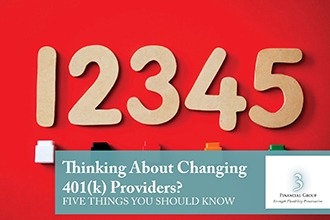Offering a competitive benefits package, including a top-notch 401(k) plan, is essential for your company to recruit and retain top talent. Today’s workers highly value employer-sponsored retirement plans: 88% of them say that an employee-funded retirement plan is important to them.1 In addition, eight out of ten new hire candidates consider retirement savings programs offered by prospective employers a major factor in their job search decisions.2
As a result, you should evaluate your 401(k) plan regularly — at least once a year — to ensure that it continues to be the right fit for your business and employees. For example, if you find during your review that you’re not satisfied with your current 401(k) provider due to high fees, poor investment performance or a lack of service and support, it may be time to consider changing providers. In addition, with many 401(k) providers offering new technology and features, now may be a good time to see if it makes sense to update your existing 401(k) offering by switching to a new provider.
If you’re considering making a change, here are five tips to help you evaluate your current provider. If you decide to switch, we can help make the transition to your new one as smooth as possible:
#1 Before considering new 401(k) providers, carefully review your existing one. Clearly identify why you’re unhappy with your current plan provider and services, then determine the improvements you’d like to see going forward. While your cons list for your existing provider may include “fees are too high,” don’t let that be the only reason for switching. Comparing plan providers based on fees alone doesn’t usually reflect the value you’re getting for what you’re paying.
Instead of focusing solely on fees, weigh your current provider — and any prospective ones in the running — based on factors such as:
· Services and design features
· Fees and structure
· Employer and employee customer service and support
· Investment options
· Fiduciary support
· Financial advisor support
#2 Get familiar with the conversion process. Let’s say you decide to change plan providers. After you choose one, what’s next? An experienced provider should do most of the heavy lifting when transitioning your plan to their platform — called a conversion. To start, you’ll need to review and complete paperwork for your current plan to share with your old and new providers.
You can also expect3:
· Your new provider to review your previous plan
· Preparation and testing to confirm a clean data transfer between providers, including participant account balances and contribution rates
· Communication to employees about the new plan
· Updates to legal and recordkeeping documents to reflect plan changes
· A blackout period, when participants won’t be able to make changes to their retirement accounts
· Final statements issued from your former 401(k) provider
· Creation and activation of participants’ new accounts
#3 Take note of applicable fees. Your current provider may charge you a termination and/or surrender fee when you switch to a new one. These fees can range from a few hundred to a few thousand dollars. Call your existing provider to determine their termination and/or surrender fees in advance to avoid any surprises. Your new provider may also charge you to establish the new plan.
#4 You don’t have to stick to your old plan design. Plan sponsors often update their plan designs when switching providers. Most plan documents allow changes to be made at any time, but keep in mind that there may be amendment, regulatory or notice requirements you must meet before these changes become effective. Also, be aware of any timing concerns — for example, investment changes must be aligned with notice and blackout period requirements. Be sure to touch base with your old and new providers to address any potential issues.
#5 Communicate plan changes to your participants. When you make changes to your 401(k), including switching providers, you’re legally required to provide participants with a blackout notice that includes information about:
· key dates — like the last date they can make contribution changes or rollover requests (since they won’t be able to make these changes during the blackout),
· how long the blackout will last
· restrictions on investment and allocation changes and
· who to contact if they need additional information
You should also provide employees with information regarding any fund or plan design changes.
It may take some time to review your current plan and switch to a new provider, if beneficial. Getting the support, and features and investment options that are best for your plan and participants will make the effort well worth it.
Need assistance? We can help you create an innovative and competitive 401(k) offering to give you an edge when it comes to recruiting and retaining talented employees. Contact us today to receive more information!
 Joanna Amberger
Joanna Amberger
CERTIFIED FINANCIAL PLANNER™
3 Financial Group
1888 Kalakaua Avenue, Suite C312
Honolulu, HI 96815
808.791.2925
www.3FinancialGroup.com
This information was developed as a general guide to educate plan sponsors and is not intended as authoritative guidance or tax/legal advice. Each plan has unique requirements, and you should consult your attorney or tax advisor for guidance on your specific situation.
2020 © 401k Marketing, LLC. All rights reserved. Proprietary and confidential. Do not copy or distribute outside original intent.


